The 64 Core Threadripper 3990X CPU Review: In The Midst Of Chaos, AMD Seeks Opportunity
by Dr. Ian Cutress & Gavin Bonshor on February 7, 2020 9:00 AM ESTAMD 3990X Against Prosumer CPUs
The first set of consumers that will be interested in this processor will be those looking to upgrade into the best consumer/prosumer HEDT package available on the market. The $3990 price is a high barrier to entry, but these users and individuals can likely amortize the cost of the processor over its lifetime. To that end, we’ve selected a number of standard HEDT processors that are near in terms of price/core count, as well as putting in the 8-core 5.0 GHz Core i9-9900KS and the 28-core unlocked Xeon W-3175X.
| AMD 3990X Consumer Competition | ||||||
| AnandTech | AMD 3990X |
AMD 3970X |
Intel 3175X |
Intel i9- 10980XE |
AMD 3950X |
Intel 9900KS |
| SEP | $3990 | $1999 | $2999 | $979 | $749 | $513 |
| Cores/T | 64/128 | 32/64 | 28/56 | 18/36 | 16/32 | 8/16 |
| Base Freq | 2900 | 3700 | 3100 | 3000 | 3500 | 5000 |
| Turbo Freq | 4300 | 4500 | 4300 | 4800 | 4700 | 5000 |
| PCIe | 4.0 x64 | 4.0 x64 | 3.0 x48 | 3.0 x48 | 4.0 x24 | 3.0 x16 |
| DDR | 4x 3200 | 4x 3200 | 6x 2666 | 4x 2933 | 2x 3200 | 2x 2666 |
| Max DDR | 512 GB | 512 GB | 512 GB | 256 GB | 128 GB | 128 GB |
| TDP | 280 W | 280 W | 255 W | 165 W | 105 W | 127 W |
The 3990X is beyond anything in price at this level, and even at the highest consumer cost systems, $1000 could be the difference between getting two or three GPUs in a system. There has to be big upsides here moving from the 32 core to the 64 core.
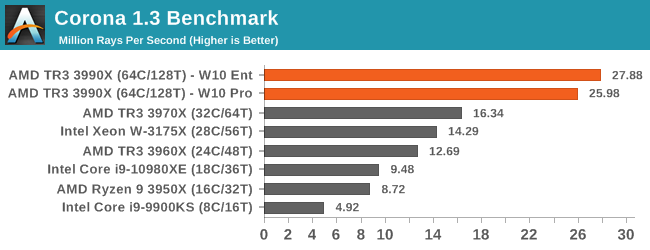
Corona is a classic 'more threads means more performance' benchmark, and while the 3990X doesn't quite get perfect scaling over the 32 core, it is almost there.

The 3990X scores new records in our Blender test, with sizeable speed-ups against the other TR3 hardware.
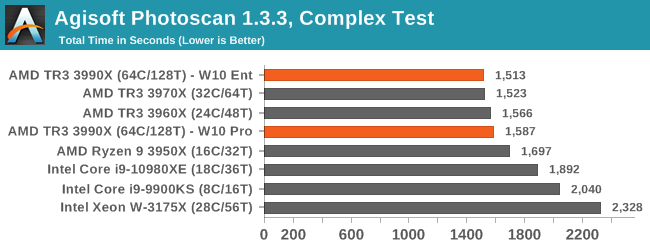
Photoscan is a variable threaded test, and the AMD CPUs still win here, although 24 core up to 64 core all perform within about a minute of each other in this 20 minute test. Intel's best consumer hardware is a few minutes behind.
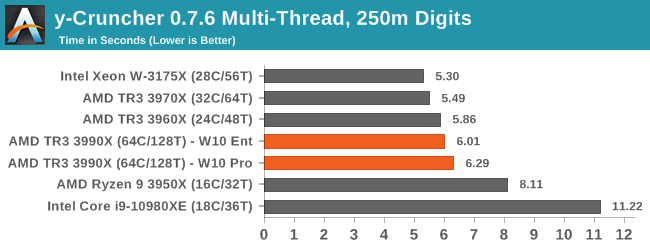
y-cruncher is an AVX-512 accelerated test, and so Intel's 28-core with AVX-512 wins here. Interestingly the 128 cores of the 3990X get in the way here, likely the spawn time of so many threads is adding to the overall time.
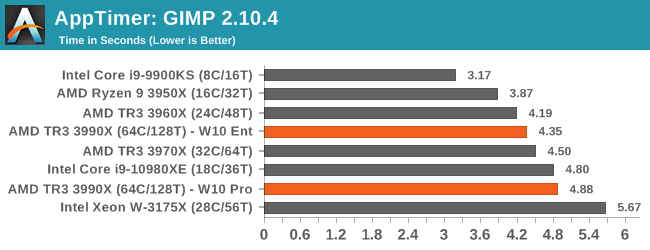
GIMP is a single threaded test designed around opening the program, and Intel's 5.0 GHz chip is the best here. the 64 core hardware isn't that bad here, although the W10 Enterprise data has the better result.
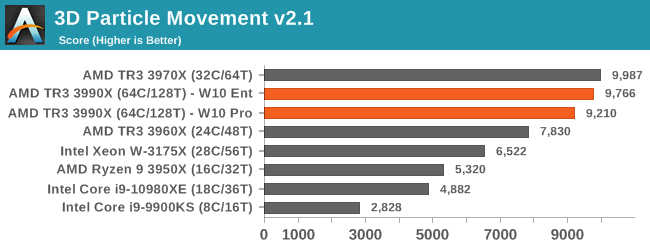
Without any hand tuned code, between 32 core and 64 core workloads on 3DPM, there's actually a slight deficit on 64 core.
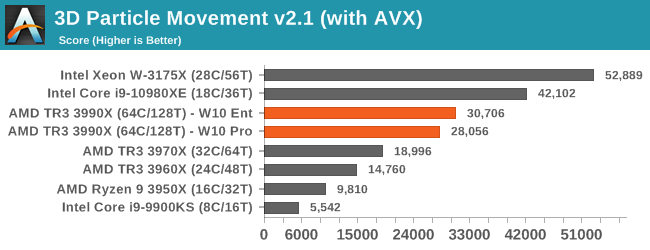
But when we crank in the hand tuned code, the AVX-512 CPUs storm ahead by a considerable margin.
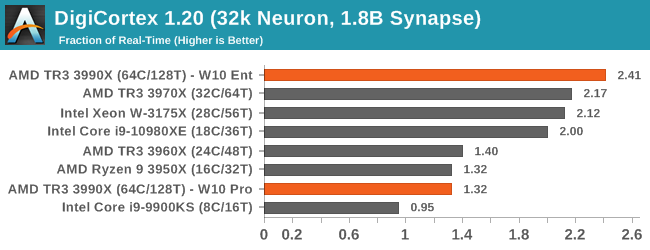
We covered Digicortex on the last page, but it seems that the different thread groups on W10 Pro is holidng the 3990X back a lot. With SMT disabled, we score nearer 3x here.
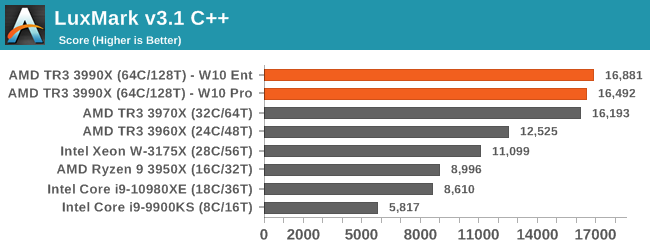
Luxmark is an AVX2 accelerated program, and having more cores here helps. But we see little gain from 32C to 64C.
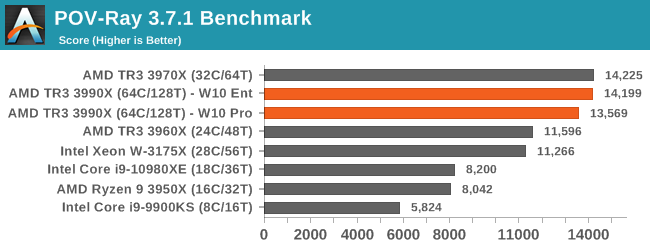
As we saw on the last page, POV-Ray preferred having SMT off for the 3990X, otherwise there's no benefit over the 32-core CPU.
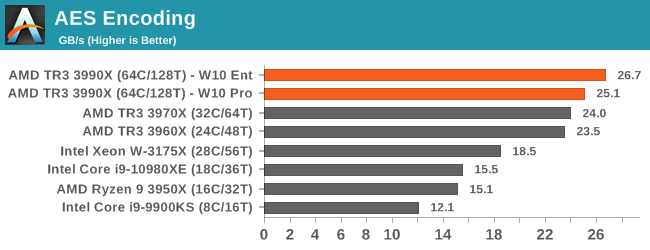
AES gets a slight bump over the 32 core, however not as much as the 2x price difference would have you believe.
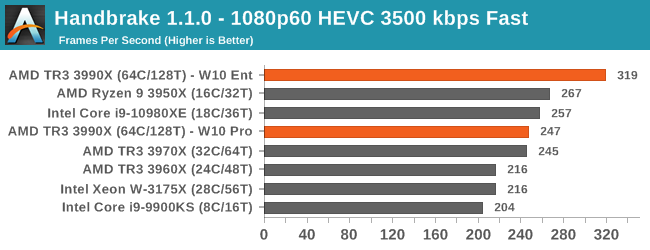
As we saw on the previous page, W10 Enterprise causes our Handbrake test to go way up, but on W10 Pro then the 3990X loses ground to the 3950X.
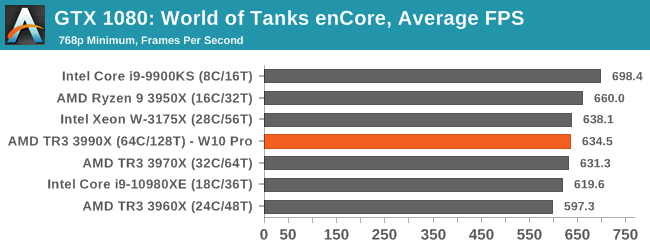
And how about a simple game test - we know 64 cores is overkill for games, so here's a CPU bount test. There's not a lot in it between the 3990X and the 3970X, but Intel's high frequency CPUs are the best here.
Verdict
There are a lot of situations where the jump from AMD's 32-core $1999 CPU, the 3970X, up to the 64-core $3990 CPU only gives the smallest tangible gain. That doesn't bode well. The benchmarks that do get the biggest gains however can get near perfect scaling, making the 3990X a fantastic upgrade. However those tests are few and far between. If these were the options, the smart money is on the 3970X, unless you can be absolutely clear that the software you run can benefit from the extra cores.










279 Comments
View All Comments
PeachNCream - Monday, February 10, 2020 - link
Computer viruses predate Lotus 1-2-3.FunBunny2 - Tuesday, February 11, 2020 - link
the point is: 1-2-3 brought the effort mainstream, by showing how DOS was just a sieve to the hardware. recall that the PC with DOS was only one of three OS available, and PC sales didn't matter much until Corporate figured out that they just had to have 1-2-3. Mitch made Bill rich, not Bill. until 1-2-3, M$ was a legit systems software maker. after that, not so much. Xenix was they're OS of the future.FunBunny2 - Tuesday, February 11, 2020 - link
... and, for the PC, not according to this history: https://content.sentrian.com.au/blog/a-short-histo..."The first computer virus for MS-DOS was “Brain” and was released in 1986. It would overwrite the boot sector on the floppy disk and prevent the computer from booting. It was written by two brothers from Pakistan and was originally designed as a copy protection."
learned how to do that from 1-2-3
Khenglish - Friday, February 7, 2020 - link
Here's Unigine Heaven software rendered:https://i.imgur.com/0dfV4pd.png
https://i.imgur.com/CEWhX31.png
Fun fact: turning on tessellation drops fps by a factor of about 20.
Spunjji - Monday, February 10, 2020 - link
Holy cow, I had no idea.I'd be interested (as a purely theoretical exercise) to see where the ideal performance balance of cores / clock speed / memory bandwidth falls when it comes to software rendering.
GreenReaper - Saturday, February 8, 2020 - link
They use DirectX on Windows, and then Microsoft provides the fallback renderer.Mikewind Dale - Friday, February 7, 2020 - link
That might actually be an interesting test for someone who wants to run legacy games that don't support newer versions of Windows, DirectX, and/or don't have graphics driver support.For example, I was trying to play the original Diablo before the GoG version came out. It didn't work on my Radeon RX580, so I had to set up a VMWare Workstation virtual machine, with 3D acceleration support. However, even though VMWare Workstation supports 3D acceleration, it's still using my CPU, not my GPU. It's just that the virtual OS has software DirectX acceleration.
Anyway, I benchmarked 3DMark2001 SE running in a Window XP virtual machine on my 8-core Ryzen 7 2700X. I actually got scores that were competitive with GPUs from the early 2000s. So my software 3D acceleration on a Ryzen 7 2700X was approximately the same speed as a GPU from circa 2001.
It would be interesting to see how well a 64 core processor does.
Khenglish - Friday, February 7, 2020 - link
I get 5947 with a 3920xm (full 4c/8t ivb with 8MB cache) at 4.3 GHz. I would expect your 2700x to be a bit more than double that.https://i.imgur.com/aeQcFuu.png
Mikewind Dale - Saturday, February 8, 2020 - link
I'm getting about 6800. So perhaps the VMWare Workstation software display device cannot fully take advantage of parallelization?Spunjji - Monday, February 10, 2020 - link
That or it's not as efficient as Microsoft's software layer at translating DirectX code into something that can run on the CPU. If you had the time, you could try running 3DMark 2001 natively on your system the way Khenglish is and see if there's a difference.